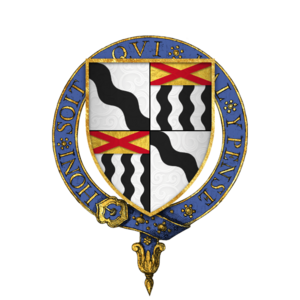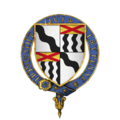John Wallop facts for kids
Sir John Wallop (born around 1490, died 1551) was a brave English soldier and a clever diplomat. He came from an old family in Hampshire, England, from a village called Farleigh Wallop. He was also a Knight of the Garter, which was a very special honor given by the king.
Contents
Sir John Wallop's Life Story
Wallop was the son of Stephen Wallop. He likely started his military career around 1511.
Early Adventures and Knighthood
Sir John Wallop probably joined an army trip to the Netherlands in 1511. He was made a knight before 1513. That year, he sailed with Sir Edward Howard on a dangerous but important journey to Brest.
In July 1513, he was the captain of a ship called the Sancho de Gara. By May 1514, he commanded the Gret Barbara. During these years, he caused a lot of trouble for French ships. In August 1515, he was sent with important letters to Margaret, Duchess of Savoy, who ruled the Netherlands.
Fighting in Portugal and Ireland
In 1516, Wallop went on a more peaceful mission. With a letter from King Henry VIII, he sailed to Portugal. There, he offered to fight against the Moors (Muslims from North Africa) at his own cost. He fought near Tangier for a while. When he returned to England, he had been made a knight of the Order of Christ by the Portuguese king.
By September 1518, Wallop was one of the king's paid officials. For the next three years, he served in Ireland under the Earl of Surrey. He often carried messages between the Lord Deputy and King Henry VIII. Wallop also played a big part in the fighting in France in 1522 and 1523. As a reward, he was made high marshal of Calais in March 1524.
Diplomatic Missions in Europe
In September 1526, Wallop began an important diplomatic trip. He first visited Margaret, Duchess of Savoy, and then the Archduke. He reached Cologne in Germany on September 30. He stayed there for a while, sending letters to Cardinal Wolsey about the war against the Ottoman Turks.
He traveled to many cities, including Brussels, Mainz, Augsburg, and Prague. In Prague, he saw Ferdinand become King of the Romans. Ferdinand later gave Wallop two valuable gold cups, which Wallop mentioned in his will. Wallop also visited King Sigismund I of Poland. He probably returned to England in the autumn of 1527.
Wallop made a quick trip to Paris in January 1528. In February, he left England for a formal diplomatic mission to France. He congratulated King Francis on getting better from an illness. He stayed in Paris for some time but was in Calais by June.
Rewards and Promotion
Wallop quickly received good rewards for his hard work. He had been a gentleman of the king's private staff for a long time. In April 1529, he became the keeper of the park of Dytton in Buckinghamshire. In June 1530, he was officially made the lieutenant of Calais. This was a big promotion, as the lieutenant of Calais was second in command after the deputy. He was in Calais during the major repairs in 1531.
Ambassador to Paris
In April 1532, Wallop was sent as ambassador to Paris. He visited Paris often and stayed there as the English representative for the next eight or nine years. He traveled to the south of France in 1533. He was in Marseilles in October for a meeting between the French king and the Pope.
In 1535, he tried to convince a famous scholar named Melanchthon to come to England. He was in Lyons from early 1536 until June. In October 1536, he was in Valence, but returned to Paris in December. He left Paris in March 1537 and was in London in May.
Captain of Guisnes
By now, Wallop was quite wealthy. In 1538, he was given lands that used to belong to a monastery called Barlinch Priory. In February 1540, Wallop became the ambassador in Paris again.
When William, Lord Sandys, the captain of Guisnes, died in December 1540, Wallop's friends helped him get the job. It was surprising because many thought his old job was better. Some even thought he was removed from Paris because he might have left England. But King Henry VIII liked Wallop, and Queen Catherine Howard also spoke up for him. So, he became captain of Guisnes in March 1541.
At Guisnes, he was very busy with building projects and attended important meetings. In 1543, when England and Spain were allies against France, Wallop was given command of the English forces in northern France. Even though he was ill for part of the time, he gained great fame. Emperor Charles V praised his actions to King Henry VIII.
Knight of the Garter and Later Years
On Christmas Eve 1543, Wallop was chosen to be a Knight of the Garter, a very high honor. He was officially installed on May 18, 1544. The war that year kept him very busy, as he had to manage many soldiers at Guisnes.
In June 1545, the king's council specially thanked him for his bravery. In 1546 and 1547, he helped set the borders of the Boulonnais region. As relations between France and England became tense, Wallop was involved in border fights. He kept his job during the war of 1549–50. After peace was made, he was again a commissioner for setting the English and French borders in November 1550.
Wallop died from the sweating sickness at Guisnes on July 13, 1551. He was buried there with a special ceremony. He had helped a lot with fixing up the local church.
Wallop's Character
Many people thought highly of Sir John Wallop. A writer named Machyn called him "a noble captain as ever was." Another diplomat, Chapuys, said in 1532 that Wallop was better at war than at politics.
Wallop's Family
Sir John Wallop was married twice. His first wife was Elizabeth, daughter of Sir Oliver St. John. She was also the widow of Gerald Fitzgerald, 8th Earl of Kildare. His second wife was Elizabeth, daughter of Sir Clement Harleston. She outlived him.
Sir John Wallop did not have any children with either of his wives. Because of this, his lands and property went to his brother, Sir Oliver Wallop. When Sir Oliver died in 1566, his son, Henry Wallop, inherited everything.
Images for kids



